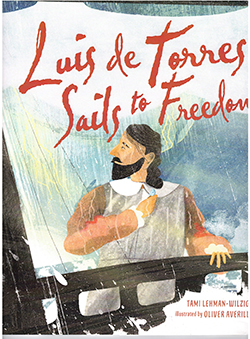Luis de Torres Sails to Freedom by Tami Lehman-Wilzig (illustrated by Oliver Averill); Kar-Ben Publishing © 2023; ISBN 9781728-445502; 18 pages; $19.99.

 SAN DIEGO – This large format book for elementary school-aged children is about Luis de Torres, who was the interpreter for Christopher Columbus on his 1492 voyage of discovery. Some of the story is true, as best as historians can tell; more of the story comes from the rich imagination of authorTami Lehman-Wilzig. Overall, it should be considered a work of historical fiction, rather than history.
SAN DIEGO – This large format book for elementary school-aged children is about Luis de Torres, who was the interpreter for Christopher Columbus on his 1492 voyage of discovery. Some of the story is true, as best as historians can tell; more of the story comes from the rich imagination of authorTami Lehman-Wilzig. Overall, it should be considered a work of historical fiction, rather than history.
Scholars believe that Luis de Torres was born Yosef ben HaLevi Halvri and that “Luis de Torres” was the name that he took during the time of the Spanish Inquisition as a supposed convert to Catholicism. In the book, he says goodbye to members of his family, who likewise have outwardly converted to Catholicism but secretly continue to practice their Judaism in the cellar of their home, where the sand-covered floors muffle the sounds of their footsteps.
De Torres was chosen as an interpreter because he spoke many languages, including Portuguese, Spanish, French, Hebrew, Arabic, and Aramaic. The voyage was supposed to leave on July 31, 1492—the deadline day for Jews to either convert to Catholicism or leave Spain. The problem for de Torres and a few other Conversos who joined the expedition was that July 31st of that year fell on Tisha B’Av, the day when Jews traditionally mourn the destruction of the First and Second Temples in Jerusalem and other tragedies. In this story, de Torres pleads with Columbus to delay the voyage rather than sail on a day that seems so ill-fated.
Columbus does not immediately accept de Torres’ advice, but when a large storm whips his three ships around their anchors, he relents and delays departure until August 3rd. De Torres, who carries a hamsa in his pocket for good luck, receives Columbus’s permission to stay aboard during the storm, thus avoiding being on Spanish soil after the July 31st deadline.
The tale ends when the storm subsides and de Torres goes up on deck, sniffing the salt air and envisioning a future of freedom when he can worship as he pleases.
If one remembers that the story is fiction, it is a captivating jaunt into what possibly might have been, with plenteous illustrations by Averill greatly enhancing the experience. If ever you have visited Freeport, Bahamas, which is a popular short cruise destination from Florida, you know that there was a Luis de Torres Synagogue there until the COVID-19 pandemic forced it to shut down. I had the opportunity to visit it back in 1988.
It was Cuba, not Bahamas, where de Torres first set foot in the new world. You can imagine him getting off the ship and calling out: “Buenos Dias? Bonjour? Salaam? Shalom?” – all languages unintelligible to the indigenous people.
From Cuba, the expedition moved to the island of Hispaniola, which today is divided between the nations of Haiti and the Dominican Republic. De Torres and some other crew members stayed in Hispaniola but apparently were killed by indigenous people sometime in 1493. Whether, as author Lehman-Wilzig imagined, he ever had the opportunity to freely worship there as a Jew is unknown.
*
Donald H. Harrison is editor emeritus of San Diego Jewish World. He may be contacted via donald.harrison@sdjewishworld.com